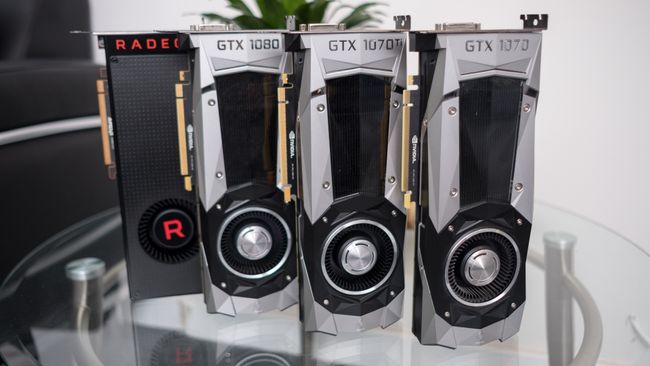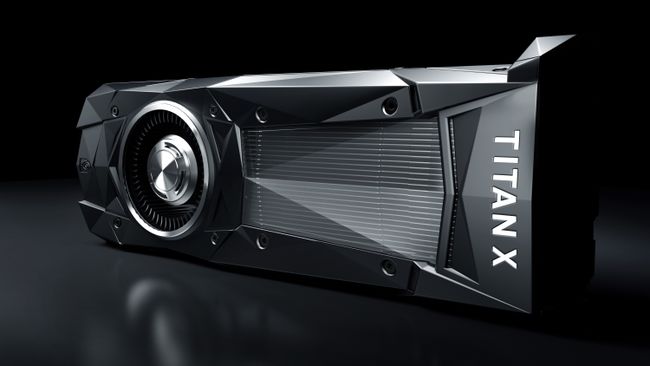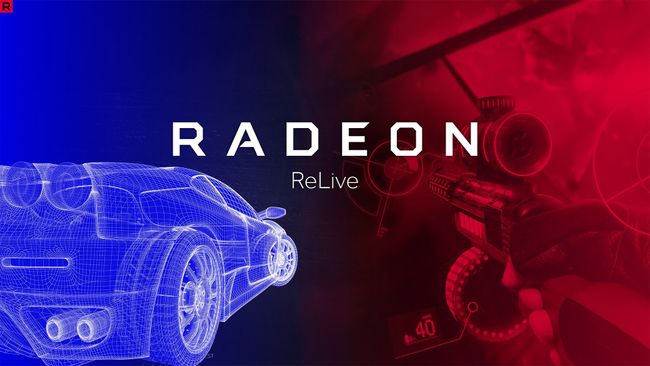AMD vs Nvidia: which should be your next graphics card?
The graphics card war never changes.

If you ask a console gamer, they’ll go on at length about the perennial rivalry between the Xbox One X and PS4 Pro, and which you should choose to play Fortnite on. However, PC gamers have a similar feud: Nvidia vs AMD. And, even if you’ve never heard about it before, the sheer amount of competition and innovation that’s resulted from this battle is nothing short of amazing.
If you’re not quite ready to pledge allegiance to one of these tech giants, though, it’s hard to figure out what the best graphics card for your needs is. Don’t worry, though, we here at TechRadar have decided to sit down and figure out once and for all the true winner in the battle of Nvidia vs AMD. (Spoiler: there is no true winner).

These days, the Nvidia vs AMD battle is in an awkward position. Almost two years after the release of the Nvidia GTX 10 series, it released the Turing architecture with the GeForce RTX 2080 Ti, RTX 2080, RTX 2070 and RTX 2060, which is leading the pack in sales. All of these GPUs are much more expensive than their predecessors. However, the GTX 1660 Ti bucks that pricing trend a bit.
On the other hand, while AMD launched Vega back in 2017, AMD’s new Radeon VII directly competes with the RTX 2080. But, that doesn’t mean it’s forgotten about the budget market – AMD keeps releasing new Polaris cards, like the Radeon RX 590, aimed at the budget-focused 1080p segment.
That’s not all: it’s gearing up to unleash the AMD Navi cards soon. At Computex 2019, the manufacturer revealed its Radeon RX 5000 series of graphics cards, with the AMD RX5700 leading the charge, that are aimed to compete with Nvidia’s mid-range RTX 2070. AMD only showed off the RX5700 at the event, but rumor has it that it will showcase up to five AMD Navi graphics cards at E3 2019.
Not to be outdone by the competition, Nvidia is speculated to reveal juiced up ‘Super’ versions of its GeForce RTX graphics cards, with clock and memory speed boosts on its highly-popular RTX 2060, 2070 and 2080 cards in order to compete with the AMD Navi GPUs. Nvidia is also hitting the creative sphere, revealing at Computex 2019 its Quadro RTX cards for laptops, which leverages the Turing architecture and real-time ray tracing for creative professionals. Leading this charge is the Quadro RTX 5000.
Speaking of ray-tracing, it doesn’t seem like AMD is jumping on that train as of yet. There’s talk of the so-called Navi 20 cards hitting the shelves in 2020, touting ray-tracing technologies, but don’t expect them to make an appearance this year.
No matter how you look at it, there are so many graphics cards from both AMD and Nvidia, so that’s why we crafted this guide – to figure out how they differ. From exclusive features to price-to-performance ratios, even down to drivers and features, we’ll help you find which graphics card manufacturer is right for you.
Price
Anyone who browses Reddit or comment sections on tech websites will tell you that AMD is widely known for its affordability, and Nvidia for its high-end performance and high prices. But, are they actually right?
Well, kind of. The Nvidia GeForce RTX 2080 Ti is listed at $1,199 (£1,099, AU$1,899), which is almost twice the price of the last-generation GTX 1080 Ti. This price bump continues down the line, with the RTX 2080 at $799 (£749, AU$1,199) and the RTX 2070 at $599 (£569, AU$899).
Luckily, you won’t have to buy a more expensive factory overclocked model of the RTX 2080 or RTX 2070 to get a decent GPU. Nvidia is going to start using the same TU104 GPU in every SKU of the RTX 2080 – rather than saving the better binned chips for the more expensive graphics cards.
During the reveal keynote, Nvidia claimed that they would start at lower prices, for instance, the 2080 Ti should be starting at $999 (about £760, AU$1,385) – but we haven’t seen any cards offered at these prices.
Right now, the most affordable Nvidia Turing card is the Nvidia GeForce GTX 1650, which starts at $149 (about £115, AU$210). Luckily, Nvidia finally has some graphics cards that can compete with AMD on the budget market. That is, at least until AMD Navi arrives.
As for AMD, you can find a Radeon RX 500 card for a pittance. But, AMD is competing with Nvidia again at the high-end with the AMD Radeon VII, which will set you back $699 (£799, AU$1,169), for performance that is equivalent to the RTX 2080 in most cases. However, because it’s compatible with Mac – something no Nvidia card can claim – it has a leg up for professionals.
No word yet as to how much the AMD Navi cards and the Nvidia’s rumored releases will cost, but the upcoming E3 2019 should reveal more details.
Still, at the end of the day, the better price is going to depend on where you’re lucky enough to find a discount.

Performance
When you’re trying to build a PC that’s more powerful than your arch-enemy’s, buying a graphics card isn’t a matter of price but performance. Packing the best performance for the lowest cost is arguably the most pertinent factor in driving GPU sales.
Right now the RTX 2080 Ti completely blows away every other consumer-grade graphics card with 11GB of GDDR6 memory and high-end Tensor and RT cores that will enable AI-controlled super sampling and real-time ray tracing. AMD right now doesn’t have anything in the same ballpark – but does that even matter?
Advertisement
AMD has always been known for being the clear value champions, whereas Nvidia usually has more powerful hardware. But, at CES 2019, AMD revealed the Radeon VII. And, now that we’ve got our hands on it for testing, we can say that it’s on equal footing with the RTX 2080 – at least until you turn DirectX 12 on. However, with its 16GB of HBM2 memory, the AMD Radeon VII will shine for any aspiring creatives out there.
The lowest end current-generation graphics card in the RTX lineup is the Nvidia GeForce RTX 2060, with performance that outmatches the AMD Vega 56 at the same price point. And, while the prices for these two GPUs are mostly comparable, AMD is currently dominating the budget-to-mid-range product stack with cards like the AMD Radeon RX 580. However, Nvidia just launched the GeForce GTX 1660 Ti, which directly competes with the AMD Radeon RX 580 in both price and performance.
In fact, with the Nvidia GeForce GTX 1660, Nvidia is coming for AMD’s mid-range market, providing a GPU that’s more affordable while still being able to handle most AAA games at max settings when playing in 1080p. Though that might not completely happen if the soon-to-be-unleashed AMD Navi cards, which are looking to compete with Nvidia’s expensive mid-range, Nvidia GeForce 2070, will be priced competitively.
At the end of the day, AMD and Nvidia are still occupying completely different sides of the marketplace right now especially since AMD might not have ray tracing until 2020, so the best choice is going to rely on what games you’re trying to play and at what resolution.
If you’re trying to play games like Assassin’s Creed Odyssey at 4K, you’re going to want to go with Nvidia. But, if you just want to play Overwatch at 1080p with a high refresh rate – go with AMD. However, that Radeon VII is looking promising for 4K performance, too – especially with that 16GB of HBM2 memory.

Software, drivers and features
One key draw to using Nvidia hardware over AMD is the Green Team’s GeForce Experience software.
Advertisement
Because it delivers driver updates and optimizes games in addition to letting you broadcast gameplay and capture screenshots as well as videos directly from its easy-to-use interface, Nvidia GeForce Experience is posited as the one PC gaming application to rule them all.
Meanwhile, AMD’s newly announced Radeon Software Adrenalin 2019 Edition aims to overtake Nvidia’s solution. The latest update is stacked features including automatic overclocking (that doesn’t need tensor cores) and stream games to your mobile device.
AMD’s latest GPU software will even let you stream VR games to your phone or standalone VR headsets. So, you can leverage the power of your AMD graphics card to play the best VR games without slowdown. Radeon Software’s underlying benefit, of course, is also more consistent updates driver updates to account for every major game release.
As of December 2016, you could already livestream via Radeon Crimson ReLive, but now you can really customize your broadcast with a Xsplit/OBS-style program from AMD and multi-channel audio control.

Still, GeForce Experience has the game optimization features we’re all crazy for. So when you don’t know what settings are best for your computer in The Witcher 3, Nvidia takes care of the heavy lifting for you.
AMD users can download and install Raptr’s Gaming Evolved tool to optimize their gaming experience. However, the add-on is less than ideal considering its biggest rival’s audience can accomplish nearly everything from within GeForce Experience. That includes using Nvidia Ansel to take way cool in-game photos at resolutions exceeding 63K (16 times that of which a 4K monitor can display).
Advertisement
Nvidia also has a leg up when it comes to streaming games whether it’s to another gaming PC with at least a Maxwell-based GPU, as well as the company’s self-made tablets and set-top box. Not to mention, Nvidia also has a cloud-based gaming service call GeForce Now available to Windows 10 and MacOS users.
And, of course you can’t talk about Nvidia in 2019 without mentioning ray tracing. When Team Green announced its Turing line of graphics card, it made huge claims about revolutionizing gaming with real-time ray traced lighting, shadows and reflections. Games with these features have been out for a while now, and while they certainly look great, these effects drain performance, even from cards designed for them.
However, it won’t just be Nvidia for long. Word on the street is that AMD Navi GPUs will have the specs to support ray tracing in the future. Soon, AMD users won’t have to live any more of their lives without ray tracing – AMD fans may have to wait until 2020, though.

Exclusivity
It was once rumored that AMD and Nvidia were enacting shady tactics, “paying off” game developers to show preferential treatment towards one or the other. Were this the case, it would certainly explain why certain games run better using GeForce graphics than Radeon and vice versa.
Fortunately, besides new technologies like ray tracing and deep learning super-sampling in the new Nvidia Turing cards, we don’t see these concerns from PC gamers as much anymore – but they still exist.
Following its Capsaicin & Cream livestream event at GDC 2017, we spoke with AMD its to discuss its strategy in contending with Nvidia. The news that the company would partner with Bethesda Softworks to optimize its games for Radeon, Ryzen or both was worrying to say the least. And it still is.
At the time, the potential for games operating more smoothly on AMD systems meant that Nvidia could fight back by partnering with an equally large publisher. Although the latter maneuver hasn’t happened yet, early Wolfenstein II performance comparisons, such as this one from TechEpiphany on YouTube have exhibited better performance and lower temps coming from the AMD Radeon RX 64 when pitted against Nvidia’s GeForce GTX 1080.
We’re not saying there’s a bias towards AMD in Bethesda’s technical design decisions, however we aren’t ready to take off our tin foil hats quite yet either.
Of course, Bethesda is hardly the only company to show favoritism to either team red or green. If you ever see an AMD or Nvidia splash screen ahead of the title page when you start a game, you can bet it will run better with that company’s hardware.
So, which is better? Neither
There’s so much to love, and in some instances “dis-love,” about both Nvidia and AMD graphics. In the end, both of these companies rely on competition with each other to thrive. Suffice to say, the Nvidia vs AMD debate requires that you understand there’s a reason Radeon and GeForce GPUs are so similar in performance right now.
Each company is doing its best to keep up with the mindshare of the other, and that’s good for us. They’re basically fighting for our money, learning from each other’s mistakes and legislating marked improvements along the way.
It’s up to you who wins the fiery contest of Nvidia vs AMD, although we will say this: Nvidia is unmatched in the 4K market right now. If it helps any, the RTX 2080 Ti is probably your best bet if you want your PC to keep up with your Ultra HD display – as long as you can afford it. If you’re on a budget, though, Nvidia and AMD graphics cards will probably be about the same once the AMD Navi cards are set loose.
These are the best PC games you can play right now




